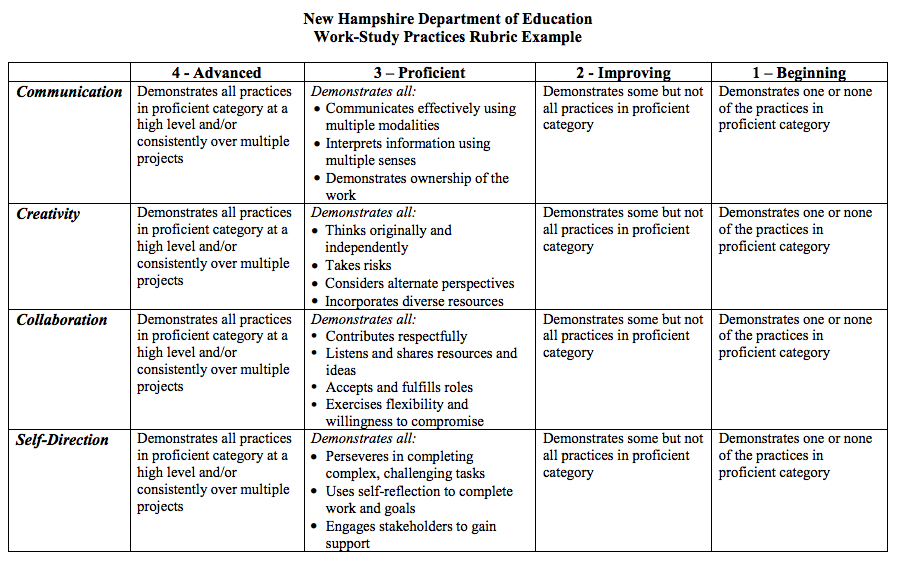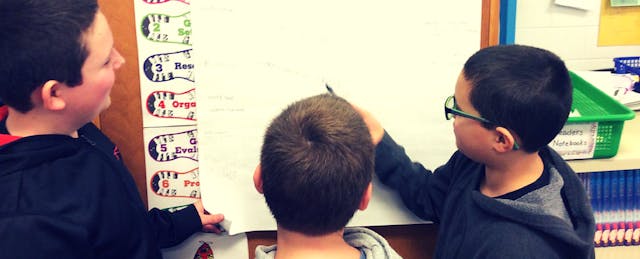Too often, teachers and administrators find themselves confined by district and state regulations that might not serve the needs of modern learners. But at Memorial Elementary School, one of two elementary schools in New Hampshire’s Sanborn Regional School District, administrators and teachers are given the freedom to experiment with cutting-edge ideas not in spite of district and state guidelines, but because of them. The independence granted to Memorial’s teachers has empowered them to make changes at the school, which serves about 300 K-5 students.
The state of New Hampshire has been gradually shifting toward competency-based education (CBE) for two decades. The changes first impacted high schools, and in the past three years, the model has made its way into K-12 classrooms. New Hampshire’s reform involves a number of efforts focused on serving the whole child and encouraging student agency. Two recent state initiatives are defining a set of non-academic work habits that contribute to student success, and developing a statewide performance-based assessment system.
While the New Hampshire Department of Education (NHDOE) is committed to supporting districts transitioning to a competency-based model, it does not dictate how the changes should roll out, so the rate of adoption varies by district. Sanborn Regional School District immediately saw the benefits of a competency-based system and began experimenting with the model. Then in 2010, after two years of research, Sanborn implemented a district-wide shift.
Rethinking Success in a Supportive Climate
As a first step, Sanborn ditched its traditional, letter-based grading system and instead adopted a set of rubrics that reflect a student’s competency on state and district academic standards. The rubrics use descriptors such as: limited, in-progress, meeting and exceeding. Within the first five years of the transition, Sanborn schools also built a competency-based curriculum and performance-based assessments based on those standards.
During this time, the NHDOE determined that in order for a competency-based model to be successful, students needed to develop a set of behaviors related to work ethic, such as time-management and responsibility. They dubbed the behaviors “Work-Study Practices” (WSP). In 2014, educators and administrators, including two representatives from Sanborn, convened to define the WSP and outline how each would be demonstrated by a graduating senior in high school. The group settled on four practices: communication, creativity, collaboration and self-direction.

When the state adopted WSP, Memorial and Bakie (the other elementary school in the district) were already following the Responsive Classroom approach and using the CARES acronym (Cooperation, Assertion, Responsibility, Empathy and Self-Regulation) to teach social and emotional skills. Both schools decided to keep CARES in place and align its habits to the WSP.
Empowering Teacher-Led Change
As Sanborn’s leaders continued to rethink the district’s practices and participate in the larger conversation about educational reform across the state, its teachers began to seek the autonomy to make changes that would increase student growth within the new model.
After spending a few years thinking deeply about assessment in a competency-based system, Memorial teachers noticed something troubling. Non-academic skills, particularly CARES skills, weren’t being measured with the same rigor as academic skills. Academic skills were assessed continually and frequently throughout the year, while CARES skills were assigned a competency level once a trimester on a report card. Teachers wondered why they weren’t assessing CARES skills in the same ongoing ways they did academic competencies, and how they could better integrate the habits into instruction each day.
This observation changed the school’s way of thinking about student success. Jonathan Vander Els, then principal at Memorial (now Executive Director of New Hampshire Learning Initiative), says teachers began asking questions about how to show growth for habits like self-regulation and cooperation. They wanted to find meaningful ways to measure these critical skills. Neither Vander Els nor Ellen Hume-Howard, Sanborn’s director of curriculum had the answers, but they both wanted to support and empower the teachers to find them.
A few Memorial teachers, including fifth grade teacher Terry Bolduc, were eager to roll up their sleeves and solve the problems around CARES integration and assessment. Bolduc spent the 2015-2016 year focused on intentionally weaving CARES into instruction, and helping students set goals to make progress on each habit. Inspired by Bolduc’s plan and determined to provide meaningful guidance to other teachers on how to better integrate and assess CARES skills, Vander Els and Hume-Howard began researching new ways of thinking about these skills.
“We saw Andy Calkins speak at a conference about MyWays in the summer of 2015 and we practically rushed the stage to talk to him afterward,” Hume-Howard laughs. She and Vander Els spoke with Calkins, deputy director of Next Generation Learning Challenges (NGLC) about the MyWays framework, which identifies 20 competencies that contribute to student success. They appreciated how it balanced academic and non-academic competencies and were hopeful that it would resolve some of the issues teachers were facing.
In April 2016, the organization launched a six-week MyWays micropilot at Memorial Elementary School and Sanborn Regional Middle School. The purpose of the micropilot was to help teachers design opportunities for students to discuss CARES. In one first grade class, students focused on a CARES area each week, planning actions to work on that skill, much like Bolduc’s fifth graders had been doing that year.
After the pilot, during which Bolduc received support from NGLC in crafting an end-of-year survey for her class, she began thinking about how her students would continue developing CARES skills when they left Memorial to enter sixth grade.
Sanborn’s middle school uses a homegrown framework for developing personal and social habits called General Learning Outcomes (GLO). The six habits outlined by GLO (self-directed learner, community contributor, complex thinker, quality producer, effective communicator, and effective and ethical user of technology) initially seemed like a far stretch from CARES. But after speaking with MyWays co-author and pilot facilitator Dave Lash, Bolduc came up with the idea to have students crossmap the two frameworks. This project helped students uncover similarities between CARES and GLO, building confidence for their transition into middle school.

When the micropilot came to a close at the end of the 2015-2016 school year, the teachers involved shared their experiences during the district-wide summer professional development. The learning gained during the micropilot had a ripple effect across the district and now all teachers at both Memorial and Bakie are helping students set intentional goals related to CARES.
Shifting Thinking Requires Trust
In a school that has historically been traditional, shifting thinking takes time. “There’s a level of trust [amongst teachers] that is required and also a level of patience,” Vander Els explains. In Sanborn’s case, district leaders were asking teachers to prepare students for future success in ways that were drastically different than what they’d been accustomed to, and teachers were uncertain that it would work.
And when the decision comes from the top-down without clear directions for implementation, mistakes are bound to be made. Hume-Howard reflects that Sanborn’s mistake was implementing new systems for a competency-based model in the wrong order. “We worked upside down. We should have started with assessment,” she explains. Teachers were building a competency-based curriculum to align with a grading system, without knowing what performance assessments would measure success.
Aligning WSP Across the District
This summer, during the district-wide professional development, Memorial teachers will work with their colleagues to unpack WSP by grade level and determine what they look like as a developmental progression. The crosswalk created to align CARES and GLO will guide this work. Additionally, teachers will begin to create WSP performance assessments, influenced by the work of MyWays pilot teachers at Memorial.
Sanborn is also interested in finding meaningful ways to measure growth for non-academic skills. The district intends to use a tool from MyWays called the whole-student competency plot to map student development of specific competencies over time, and eventually hopes to find software that can track progress and assessment of WSP.


